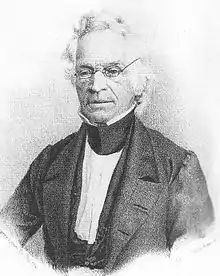Brown Bros. & Co.
Brown Bros. & Co. was an investment bank from 1818 until its merger with Harriman Brothers & Company in 1931, to form Brown Brothers Harriman & Co. According to Zachary Karabell:
In its first hundred years, the firm helped to make paper currency standard in the U.S., underwrote the earliest railroad and trans-Atlantic steamship companies and almost unilaterally created the first foreign exchange system between the American dollar and the British pound. In the 20th century, it became a cornerstone of what came to be known as “the Establishment,” as its partners entered the halls of government to shape the global economic and security system that remains the world’s institutional architecture.[1]
| Type | Partnership |
|---|---|
| Industry | Investment Banking Commercial Banking |
| Founded | 1818 |
| Founder | George and John Brown |
| Defunct | 1931 |
| Fate | Merge |
| Successor | Brown Brothers Harriman & Co. |
| Headquarters | , United States |
| Owner | John Crosby Brown |

History
Brown Brothers, an investment bank and trading company, was founded in 1818 in Philadelphia, Pennsylvania, by George Brown and John Brown, sons of former Ulster linen trader Alexander Brown (1764–1834) who had established a firm in Baltimore, Maryland. In 1825, the third son, James Brown (1791–1877), opened an affiliate in New York City under the name Brown Brothers and another in Boston, Massachusetts, in 1845.[2] These firms were later merged under the name. James Brown's son, John Crosby Brown (1838–1909), would be a driving force for growth, making Wall Street in New York the center for operations and seeing the bank become major lenders to the textile, commodities, and transportation industries.
In 1931, the firm merged with Harriman Brothers & Company, another Wall Street firm owned by W. Averell Harriman and E. Roland Harriman, to form Brown Brothers Harriman & Co.
In 1964, John A. Kouwenhoven, professor of English at Barnard College and the author of The Columbia Historical Portrait of New York, among other works, was hired by Brown Brothers Harriman to identify and amass records of historical value to the firm. His title was Director of the Historical Files, which were to serve, among other purposes, as the research materials for the writing of Partners in Banking, commissioned by the publishers Doubleday & Co. to celebrate the firm's 150th anniversary in 1968. These files are held at the New-York Historical Society. The business records of Brown Brothers & Co. in New York City, including 176 volumes dated 1826–1880, were deposited at The New York Public Library and are almost entirely from the business career of James Brown.
References
- Karabell, 2021.
- "An Artistic Addition to Brown Brothers' Wall Street Offices Under Construction. Banking House Will Occupy Hanover Street Block Front from Wall to Beaver Street". The New York Times. September 3, 1916. Retrieved 2011-02-14.
To prepare the site for the new addition to Brown Brothers' banking building on Wall Street, wreckers began last week tearing down three of the oldest landmarks still remaining on Hanover Street. They comprise the ancient structures at 8, 4 and 5 Hanover Street, the latter forming the immediate corner of Beaver Street.
Further reading
- Brown, John Crosby. A Hundred Years of Merchant Banking, A History of Brown Brothers and Company. New York (1909) online
- Karabell, Zachary. "The Capitalist Culture That Built America: Since the early 19th century, the firm of Brown Brothers defined the distinctive American mix of financial power and public service. Its example can still instruct us." Wall Street Journal May 14, 2021
- Killick, John R. "The Cotton Operations of Alexander Brown and Sons in the Deep South, 1820–1860." Journal of Southern History 43.2 (1977): 169–194. online
- Kouwenhoven, John Atlee. Partners in Banking: An Historical Portrait of a Great Private Bank, Brown Brothers Harriman & Co., 1818–1968 (1968) online
- Rappleye, Charles. Sons of Providence: The Brown brothers, the slave trade, and the American revolution (Simon and Schuster, 2007). excerpt
External links
- "Finding aid to the Brown Brothers & Company records at The New York Public Library". The New York Public Library.
- "Guide to the Records of Brown Brothers Harriman at the New York Historical Society". New York University.